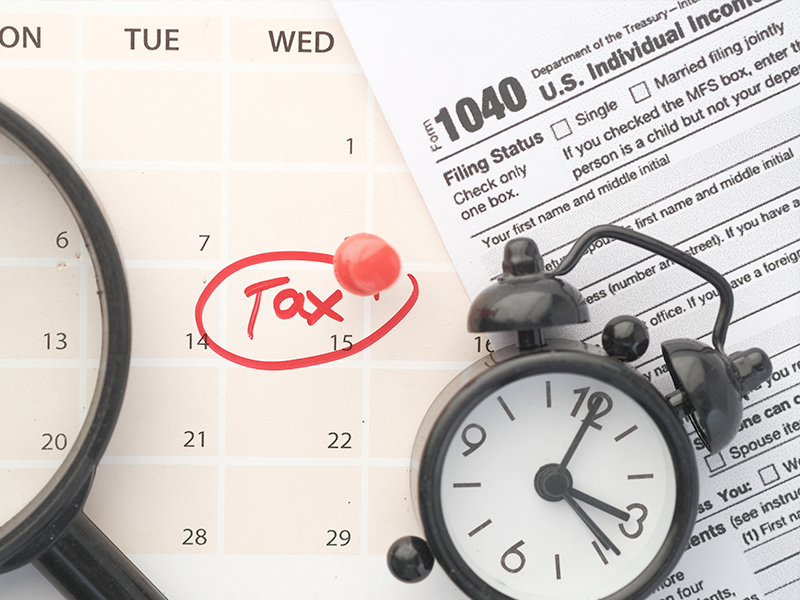
Federal Estate Tax
As the old saying goes, you can't cheat death or taxes. In fact, you might still owe taxes after you die! One of these taxes is the federal estate tax. Generally, this is a tax that may be imposed on property you own at your death.
Any U.S. citizen who leaves an estate (plus adjusted taxable gifts) in excess of the estate and gift tax basic exclusion amount ($12,060,000 in 2022, $11,700,000 in 2021) may be subject to estate tax.
Estimating and planning for the estate tax may be important to you because this could be one of the largest expenses your estate may have to pay. It also means that a significant part of your estate may go to the government and not to your beneficiaries.
Caution: Transfers of property you make to persons who are more than one generation below you (e.g., a grandchild or great-nephew) may also be subject to generation-skipping transfer (GST) tax, a separate and additional type of federal transfer tax. Some states also impose their own gift tax, estate tax, and GST tax. These taxes are not discussed here, but you should take them into account when planning your estate. See your financial professional for more information.
The federal unified tax system
Under federal law, all property transfers are taxed under a unified gift and estate tax system. This means that lifetime gifts are reported and gift tax owed is paid annually. Upon your death, gifts are added back to your estate for estate tax calculation purposes, even though gift tax may have already been paid on them. Any gift tax paid is subtracted from estate tax owed. The result of this system is that you pay tax on the cumulative amount of wealth you give away, which effectively pushes your estate into a higher tax bracket.
Calculating estate tax
Estate tax is imposed on your taxable estate, which is the value of your gross estate reduced by the qualified conservation easement exclusion and various deductions.
Your cumulative taxable transfers are calculated by adding adjustable taxable gifts you made during life to your gross estate. A tentative tax is calculated on your cumulative taxable transfers, as well as on your adjusted taxable gifts. The tax is calculated under the Unified Tax Rate Schedule, which is graduated; the larger the value of your cumulative transfers, the greater the tax rate (much like your income tax). A tentative estate tax is calculated by subtracting the gift tax on adjustable taxable gifts from the estate tax on cumulative taxable transfers.
Credits are subtracted from the tentative estate tax, resulting in the estate tax that is owed.
The estate tax calculation looks like this:
Tip: If you have not made taxable gifts during your lifetime, there is a shortcut that can be used to estimate what your estate tax would be if you were to die in 2022. Simply subtract the applicable exclusion amount from the taxable estate, and multiply this amount by 40 percent. For example, estate tax on a $13,060,000 taxable estate for a decedent dying in 2022 would be $400,000 [$13,060,000 taxable estate minus $12,060,000 applicable exclusion amount equals $1,000,000; multiplied by the 40 percent top tax rate equals $400,000].
Estimating and planning for the estate tax may be important to you because this could be one of the largest expenses your estate may have to pay.
The Tax Cuts and Jobs Act, signed into law in December 2017, doubled the gift and estate tax basic exclusion amount to $11,180,000 in 2018. The exclusion is $12,060,000 in 2022. After 2025, the exclusion is scheduled to revert to its pre-2018 level and cut by about one-half.

Determining what is taxable
The first step in estimating estate tax is to determine what is taxable. This includes property owned by you (or deemed to be owned by you) at the time of your death (the gross estate).
The gross estate includes all property and property interests — of any description, wherever located — at the time of your death. This includes property that passes through probate and property inherited directly by joint owners or designated beneficiaries. Generally, your property includes:
Generally, the value assigned to each property item is the fair market value (FMV) on the valuation date, though other valuation methods may apply. Simply stated, FMV means the price at which property would sell for on the open market.
Tip: The valuation date is generally the date of death, but can be six months after the date of death if the executor makes a special election for this. This may be beneficial if property decreases in value during the six-month period. This may happen, for instance, if you own a small business that suffers because of your death.
Determining what isn't taxed
The second step in the estate tax calculation is to determine what isn't taxed. Certain amounts are excluded from, and deductions are subtracted from, your gross estate. The result is your taxable estate.
The following exclusions are allowed:
Technical note: While the applicable exclusion amount (or basic exclusion amount; sometimes referred to as an exemption) indicates the amount of property that can be sheltered from federal gift or estate tax by the unified credit, the applicable exclusion amount is not actually an exclusion (or exemption). So do not reduce the gross estate by the applicable exclusion amount. Instead, the unified credit is subtracted below as a credit against tax.
The following deductions are allowed:
Tip: If your spouse is not a U.S. citizen, the marital deduction is generally not available unless you use a qualified domestic trust (QDOT).
This is what your calculation should look like at this point:
Calculating the tentative estate tax
As noted earlier, deductions are subtracted from the gross estate, resulting in the taxable estate. The taxable estate is then added to your adjusted taxable gifts, resulting in your cumulative transfers.
Generally, adjusted taxable gifts are gifts made after 1976 that are not "qualified transfers" for educational or medical purposes or transfers that qualify for the annual gift tax exclusion, marital deduction, or charitable deduction. Generally, the value of a gift is the FMV of the property on the date the gift is made.
A tentative tax is calculated on your cumulative taxable transfers, as well as on your adjusted taxable gifts. The tax is calculated under the Unified Tax Rate Schedule (see below) for gift tax and estate tax, which is graduated. A tentative estate tax is calculated by subtracting the gift tax on adjustable taxable gifts from the estate tax on cumulative taxable transfers. [The gift tax on adjustable taxable gifts is calculated as reduced by the unified credit available in the year of any gift.]
As a result of calculating tax this way, the larger the value of your cumulative transfers, the greater is the tax rate on your taxable estate.
This is what your calculation should look like at this point:
Deducting credits
Once your tentative estate tax has been calculated, there are credits available to apply against the tax.
This is what your calculation should finally look like:
Achieving peace of mind
Although estimating estate tax can be complicated, you can do it if you proceed step by step. Estimating estate tax is an important step in formulating and implementing a successful estate plan, and the peace of mind that comes with that should be worth your time and trouble.

Under the federal unified tax system, estate tax is calculated by taking into account both your taxable estate and the adjusted taxable gifts you make during your lifetime. The result of this system is that you pay tax on the cumulative amount of wealth you give away, which effectively pushes your estate into a higher tax bracket.
Federal Gift and Estate Exclusion Limits and Tax
For 2022, there is a $12,060,000 gift and estate tax basic exclusion amount, the estate of a deceased spouse can transfer any unused applicable exclusion amount to the surviving spouse, and the top gift and estate tax rate is 40%.
| Year | Amount effectively excluded from federal gift and estate tax | Highest federal gift and estate tax rates |
|---|---|---|
| 2021 | $11,700,000 plus DSUEA* | 40% |
| 2022 | $12,060,000 plus DSUEA* | 40% |
*Basic exclusion amount plus deceased spousal unused exclusion amount (exclusion is portable for 2011 and later).
Gift and Estate Tax Rate Schedules
For 2011 and later years, the credit shelter amount is portable, that is, any exclusion that is unused by the first spouse to die may be used by the surviving spouse for gift and estate tax purposes.
| Taxable Gift/Estate | Tentative Tax Equals | Plus | Of Amount Over |
|---|---|---|---|
| 0 - $10,000 | $0 | 18% | $0 |
| $10,000 - $20,000 | $1,800 | 20% | $10,000 |
| $20,000 - $40,000 | $3,800 | 22% | $20,000 |
| $40,000 - $60,000 | $8,200 | 24% | $40,000 |
| $60,000 - $80,000 | $13,000 | 26% | $60,000 |
| $80,000 - $100,000 | $18,200 | 28% | $80,000 |
| $100,000 - $150,000 | $23,800 | 30% | $100,000 |
| $150,000 - $250,000 | $38,800 | 32% | $150,000 |
| $250,000 - $500,000 | $70,800 | 34% | $250,000 |
| $500,000 - $750,000 | $155,800 | 37% | $500,000 |
| $750,000 - $1,000,000 | $248,300 | 39% | $750,000 |
| $1,000,000 ------------ | $345,800 | 40% | $1,000,000 |
| Credit shelter amount
$11,700,000 in 2021 $12,060,000 in 2022 |
Credit amount
$4,625,800 in 2021 $4,769,800 in 2022 |
A word about state death taxes
The individual states also impose their own "death taxes," in the form of an estate tax or an inheritance tax, or both. Whether your estate will be subject to state death taxes depends on the size of your estate and the tax laws in effect in the state in which you are domiciled. Some states also impose a separate gift tax.

A word about generation-skipping transfer (GST) tax
GST tax is an additional tax imposed on property you transfer to an individual who is two or more generations below you (e.g., a grandchild or great-nephew). A flat tax rate equal to the highest estate tax rate then in effect is imposed on every generation-skipping transfer you make over the GST tax exemption, which is $12,060,000 (in 2022, $11,700,000 in 2021). Some states also impose their own GST tax.
What do You Need To Open A Checking Account
Trustco offers several different debit cards for their customers. Find out which card best fits your needs.
Why You Should Open A Health Savings Account
Do you wish you had better control over how you spend your health-care dollars? If so, you may be interested in an alternative to traditional health insurance called a health savings account (HSA).
Environmental
At Trustco Bank we understand the importance of limiting our carbon footprint while delivering the best value to our shareholders.



